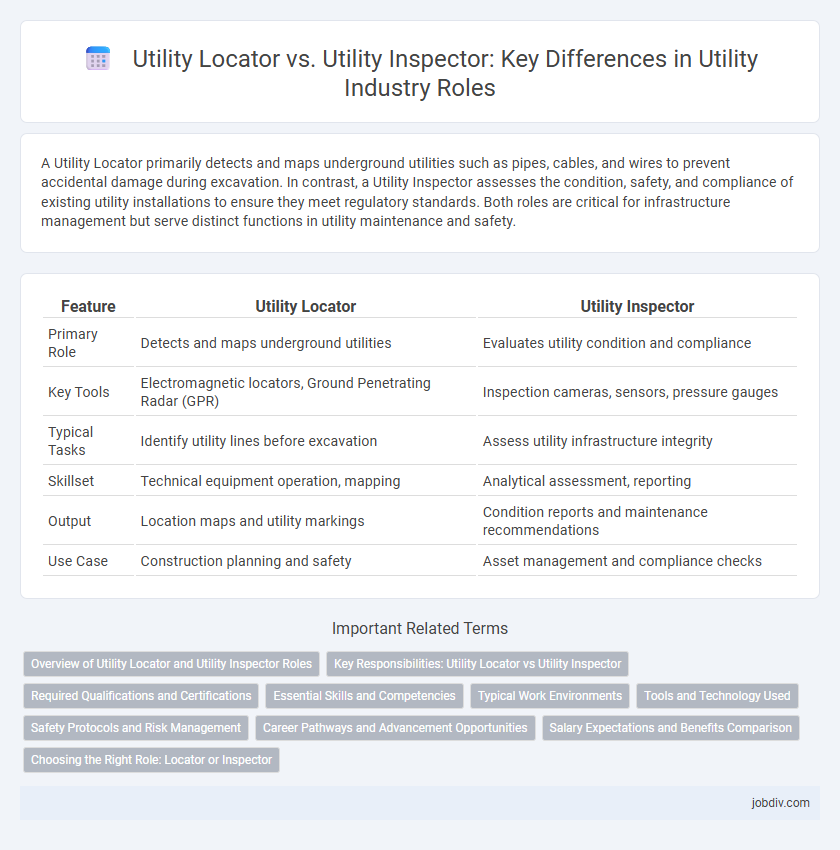A Utility Locator primarily detects and maps underground utilities such as pipes, cables, and wires to prevent accidental damage during excavation. In contrast, a Utility Inspector assesses the condition, safety, and compliance of existing utility installations to ensure they meet regulatory standards. Both roles are critical for infrastructure management but serve distinct functions in utility maintenance and safety.
Table of Comparison
| Feature | Utility Locator | Utility Inspector |
|---|---|---|
| Primary Role | Detects and maps underground utilities | Evaluates utility condition and compliance |
| Key Tools | Electromagnetic locators, Ground Penetrating Radar (GPR) | Inspection cameras, sensors, pressure gauges |
| Typical Tasks | Identify utility lines before excavation | Assess utility infrastructure integrity |
| Skillset | Technical equipment operation, mapping | Analytical assessment, reporting |
| Output | Location maps and utility markings | Condition reports and maintenance recommendations |
| Use Case | Construction planning and safety | Asset management and compliance checks |
Overview of Utility Locator and Utility Inspector Roles
Utility locators specialize in detecting and mapping underground utilities using advanced technologies such as ground-penetrating radar and electromagnetic locators to prevent damage during excavation. Utility inspectors focus on assessing the condition, safety, and compliance of existing utility infrastructure through visual inspections and testing procedures. Both roles are critical for maintaining infrastructure integrity but differ in their primary objectives--locators emphasize detection and mapping, while inspectors concentrate on evaluation and safety assessment.
Key Responsibilities: Utility Locator vs Utility Inspector
Utility Locators are responsible for identifying and marking underground utilities such as gas lines, water pipes, and electrical cables to prevent damage during excavation. Utility Inspectors oversee the condition and compliance of utility installations, ensuring adherence to safety standards and regulatory requirements. While Locators focus on precise detection and mapping, Inspectors prioritize evaluation, maintenance verification, and reporting.
Required Qualifications and Certifications
Utility locators must possess specialized training in subsurface detection technologies such as ground-penetrating radar (GPR) and electromagnetic induction, often requiring certifications like the National Utility Locating Contractors Association (NULCA) or American Society of Civil Engineers (ASCE) qualifications. Utility inspectors typically hold advanced certifications in infrastructure assessment, including the American Concrete Institute (ACI) certification and Occupational Safety and Health Administration (OSHA) training, to ensure compliance with safety regulations and standards. Both roles demand thorough knowledge of utility maps, legal regulations, and proper documentation, but inspectors generally require higher-level technical and safety certifications due to the critical nature of their assessments.
Essential Skills and Competencies
Utility Locators specialize in precise detection and mapping of underground utilities using advanced electromagnetic and ground-penetrating radar technologies, requiring strong technical aptitude and spatial awareness. Utility Inspectors possess deep knowledge of utility system standards, safety regulations, and quality control, focusing on assessing installation integrity and ensuring compliance. Both roles demand sharp problem-solving abilities and effective communication skills to coordinate with construction teams and mitigate risks on site.
Typical Work Environments
Utility locators typically operate in outdoor environments such as construction sites, roadways, and urban development areas where underground utilities need identification. Utility inspectors often work both outdoors and indoors, inspecting utility lines, equipment, and infrastructure in residential, commercial, and industrial settings to ensure compliance and safety. Both roles require access to diverse locations, including trenches, utility vaults, and substations, emphasizing adaptability to various physical conditions.
Tools and Technology Used
Utility Locators rely on tools such as electromagnetic locators, ground-penetrating radar (GPR), and radio frequency (RF) devices to detect underground utilities with precision. Utility Inspectors utilize advanced inspection cameras, remote sensors, and data analytics software to assess the condition and compliance of utility infrastructure. Both roles incorporate GPS mapping technology to ensure accurate documentation and reporting of utility systems.
Safety Protocols and Risk Management
Utility locators utilize advanced ground-penetrating radar and electromagnetic detection tools to identify underground utilities, reducing hazards during excavation and preventing accidental damages. Utility inspectors conduct thorough assessments of existing infrastructure, ensuring compliance with safety protocols and identifying potential risk factors such as corrosion, leaks, or structural weaknesses. Both roles are crucial for risk management, with locators preventing initial damages and inspectors maintaining ongoing safety and operational integrity.
Career Pathways and Advancement Opportunities
Utility locators specialize in identifying and mapping underground utilities using advanced detection technologies, providing essential groundwork for construction and maintenance projects. Utility inspectors focus on evaluating the condition and compliance of utility systems, ensuring safety and regulatory adherence through rigorous assessment protocols. Career advancement for utility locators often leads to supervisory roles or technical specialist positions, while utility inspectors can progress into inspection management, engineering support, or regulatory enforcement careers.
Salary Expectations and Benefits Comparison
Utility locators typically earn between $40,000 and $60,000 annually, benefiting from hazard pay and overtime opportunities, while utility inspectors command higher salaries ranging from $55,000 to $80,000 due to their specialized inspection and compliance responsibilities. Benefits for utility inspectors often include comprehensive health insurance, retirement plans, and professional development allowances, whereas utility locators may receive more field-based perks such as travel allowances and safety gear provisions. The salary gap reflects the increased technical expertise and regulatory accountability required of inspectors compared to locators.
Choosing the Right Role: Locator or Inspector
Utility locators specialize in accurately identifying and mapping underground utilities to prevent damage during excavation, using advanced tools such as ground-penetrating radar and electromagnetic detectors. Utility inspectors focus on assessing the condition, compliance, and safety of existing utility infrastructure through detailed visual and technical evaluations. Selecting the right role depends on project needs: locators are essential for risk mitigation before digging, while inspectors ensure ongoing maintenance and regulatory adherence.
Utility Locator vs Utility Inspector Infographic

 jobdiv.com
jobdiv.com